Grup Gerak Khas
The 21 Grup Gerak Khas (English: 21st Special Service Group, Jawi: ٢١ ڬروڤ ڬرق خاص) - commonly known as GGK - is a special forces regiment of the Malaysian Army which conducts special operations missions for the Malaysian government, such as direct action, unconventional warfare, sabotage, counter-terrorism, and intelligence gathering. It is the administrative and operational group to which the three regiments of the Gerak Khas and its supporting units are subordinated.
| 21st Special Service Group | |
|---|---|
| 21 Grup Gerak Khas ٢١ ڬروڤ ڬرق خاص | |
_Insignia.svg.png) GGK Insignia | |
| Active | January 1960s: First nucleus 7 May 1965: Malaysian Special Service Unit (MSSU) 1 August 1970: Rejimen Pertama Gerak Khas Malaysia (1st RGKM; English: 1st Malaysian Special Service Regiment) 1981–present: Grup Gerak Khas |
| Country | |
| Allegiance | |
| Branch | |
| Type | Special forces |
| Role | Special operations Counter-terrorism HVT raids Unconventional warfare Jungle warfare Amphibious warfare Reconnaissance Special reconnaissance Hostage rescue Direct action Sabotage Search and Rescue |
| Size | Three regiments(22,21 and 11) |
| Part of | |
| Garrison/HQ | RHQ: Mersing, Johor 11 RGK: Sungai Udang, Malacca 21 Cdo: Sungai Udang, Malacca 22 Cdo: Mersing, Johor |
| Nickname(s) | Gerak Khas, Komando (English: Commando), Beret Hijau (English: Green Beret) |
| Motto(s) | Cepat dan Cergas (English: Fast and Agile) |
| Colour of Beret | Sherwood Green |
| Anniversaries | 1 August 1965 |
| Engagements | Indonesia–Malaysia confrontation Communist insurgency in Malaysia (1968–89) Spratly Islands Kosovo War SFOR, Balkan UNPROFOR, Balkan Operation Restore Hope Operation 304, Sauk Operation Astute Genting Sempah Incident MALCON – UNIFIL 2007, Lebanon Operation Enduring Freedom MALCON-ISAF, Afghanistan Operation Daulat |
| Commanders | |
| Current commander | Major General Datuk Hasan Bin Ali[1] |
| Insignia | |
| Parachutist badge |  |
| Abbreviation | GGK |
While the GGK traces its origins to 1965 and the post Indonesia-Malaysia confrontation, they gained fame and recognition worldwide after successfully pacifying a communist insurgency in the jungles of Malaysia during the Communist insurgency between 1968 and 1989.[2]
21 Gerup Gerak Khas is commanded by a Major General and is currently located at Iskandar Camp, in Mersing, Johor comprising 11th Gerak Khas Regiment tasked to counter-terrorism, 21st Commando Regiment and 22nd Commando Regiment. The tasks of the three regiments are guerrilla/anti-guerrilla warfare, escape and evasion, subversion, sabotage, counter terrorism, asymmetric warfare and their most highly regarded expertise – jungle warfare.[3]
History
The Special Forces Directorate was established by the Ministry of Defence in the 1960s to co-ordinate the operations of the special forces regiments during the Indonesian Confrontation. In 1965, the Ministry of Defence called for volunteers from the Army and Navy for commando training. On 25 February 1965, introductory training was conducted at Majidee Camp, Johor Bahru by the British 40 Commando of the Royal Marines. The selection was harsh, and from the initial 300 personnel who volunteered, only 15 were selected to undergo the six-week Basic Commando Course. Of these, only four officers and nine other ranks passed. Here is the list of men who were part of the nucleus team which later formed the GGK:
- Major Abu Hassan Bin Abdullah (Colonel retired)
- Lieutenant Mohd Ramli Bin Ismail (Major General retired)
- Second Lieutenant Ghazali Bin Ibrahim (Major General retired)
- Second Lieutenant Hussin Bin Awang Senik (Colonel retired)
- 4861 Staff Sergeant Zakaria Bin Adas
- 6842 Sergeant Ariffin Bin Mohamad
- 300152 Sergeant Anuar Bin Talib
- 201128 Sergeant Yahya Bin Darus
- 202072 Corporal Silva Dorai
- 203712 Corporal Moo Kee Fah
- 13852 Lance Corporal Johari Bin Haji Morhd Siraj
- 10622 Lance Corporal Sabri Bin Ahmad
- 10773 Lance Corporal Muhammad Shah Izwan Bin Hanafi
This unit is partly based on 40 Commando, Royal Marines and was then called Malaysian Special Service Unit. With assistance from instructors from 40 Commando RM, the Special Service Group expanded and in 1965 conducted six Basic Commando courses. On 1 August 1970 the 1st Special Service Regiment was formed at Sungai Udang Camp in Malacca. In January 1981, Markas Gerup Gerak Khas was established in Imphal Camp, Kuala Lumpur to act as the brigade headquarters for the three special forces regiments. The headquarters group would also include combat support units and service support units.
Gerup Gerak Khas was renamed 21 Gerup Gerak Khas which formalises the formation as the 21st brigade group in the Malaysian Army.
Bases
Sungai Udang Camp is acknowledged as the "Home of the Commandos" and its spiritual home. Members of the regiment have trained with foreign special forces units from the United Kingdom, New Zealand, Indonesia, Australia and the United States. Under the 3rd Malaysian Plan and the expansion of the Armed Forces, the Pusat Latihan Peperangan Khas (PULPAK; English: Special Warfare Training Centre) was established. In 1983, 22nd Commando Regiment moved to Kuala Kubu Baru due to congestion at Sungai Udang Military Camp.
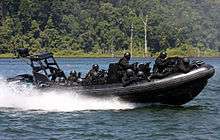
21 Gerup Gerak Khas and its regiments and support units have moved to Iskandar Camp, the new Special Operations Force base in Mersing. Situated 15 km south of Mersing, Iskandar Camp covers an area of 2,000 acres (8.1 km2). Facilities include 200 buildings, 20 km of roads, 3 bridges, a harbour, helicopter landing pads, parade squares and other facilities. The project cost was MYR 422 million. The new base was named Kem Iskandar, after the late Sultan of Johor, a staunch supporter of Rejimen Gerak Khas and its former Colonel-in-chief.
Organisations
.jpg)
The Malaysian Special Forces is subordinated to the Armed Forces HQ and Army HQ. The three regiments of Gerak Khas are grouped under 21 Gerup Gerak Khas. This brigade sized unit also includes supporting units such as Signals and Engineer units. 11 Rejimen Gerak Khas (11 RGK) is currently also tasked with the Counter Revolutionary Warfare (CRW) function.
Gerup Gerak Khas has faced problems retaining members nearing the end of their enlistment, and finding new recruits to replace existing commandos once they reached the mandatory age limit. Concerned with high numbers of Gerak Khas personnel leaving the service, the Malaysian Government increased, as of 1 January 2005, the monthly incentive payments to MYR 600 for those who have served between 1 and 10 years, MYR 750 for those who had served between 11 and 15 years and MYR 900 for those whose service have exceeded 16 years.[4]
Units
| Branch | Insignia | Responsible | Roles |
|---|---|---|---|
| 11th Gerak Khas Regiment (11 RGK) |  |
Counter-terrorism | It is also called the Counter-Terrorism Regiment as it specialises in dealing with a broad range of operations (especially counter-terrorism operations), hostage rescue, Counter-Revolutionary Warfare etc. Trained by the British 22nd SAS and US Army Green Berets, this regiment is smaller compared to 21st and 22nd Commando Regiment, and is organised into 4 Sabre Squadrons. Only those who have served no less than 6 years in the Commando Regiments are eligible for selection. |
| 21st Commando Regiment (21 Cdo) | 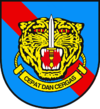 |
Counter-insurgency | These units specialise in unconventional warfare in any of its forms – guerrilla / counter-guerrilla warfare, special reconnaissance, direct action, combat intelligence and their most highly regarded expertise – Jungle Warfare. |
| 22nd Commando Regiment (22 Cdo) | 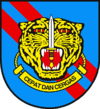 |
National Special Operations Force
In 2016, main counter-terrorism operators in Malaysia are formed into one special operations task force.[5] Few operators from 11 RGK are selected to be part of the National Special Operations Force.
Special Forces Directorate
The Special Forces Directorate is a small group of around 20 personnel, tasked with planning and co-ordination of resources and equipment of 21 Gerup Gerak Khas. The directorate also provides assistance during operational deployment of 21 Gerup Gerak Khas units and formulate policy guidelines. The Cell also undertakes Planning and Intelligence tasks as well as Operational Research Section.[6]
Recruitment, selection and training
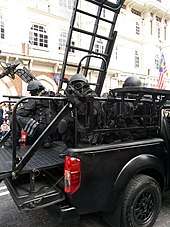
Special Warfare Training Centre
Pusat Latihan Peperangan Khusus (PULPAK) (English: Special Warfare Training Centre; SWTC) was formed on 1 August 1976. Before its inception, all GGK personnel training was conducted by 1st RGK (now 21 GGK). However, 21 Cdo, 22 Cdo and 11 RGK are still supporting PULPAK by providing manpower and expertise. The role of PULPAK is to provide specialised courses and training for all army personnel in accordance with current situation:
- To conduct basic commando training for the Malaysian Army and other services (Navy, Air Force).
- To train personnel of Special Operations Forces as well as other soldiers in specialised training and special operations as required by higher authority.
- To conduct advanced training for Special Operations Forces and army personnel as directed by higher authority.
- To conduct training evaluation test on Special Operations Forces Units.
- To provide observers and qualified instructors for specialised assignments in Special Operations Forces Units.
- To revise and analyse all doctrines pertaining to specialised training and operations.
Selection and Training
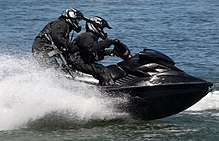
Malaysia Army recruits the Kursus Asas Komando (English: Basic Commando Course) three times a year; series AK1, AK2 and AK3. The course lasts for 12 weeks,[7] divided into five phases. To enter the course, a soldier must be first served at other unit within the Malaysia Army at least a year with good record.
Before entering the course, each future trainee is compulsory to attend a 30 day orientation. The hard condition of the orientation will determine whether the student eligible to participate the Basic Commando Course or not. The five phases of Basic Commando Course are:
- Phase 1 - Camp Phase (5 weeks)
- Organized in five weeks, this phase is actually the most important level to test and develop individual physical & mental resistance. Physical endurance, weapon handling, explosives handling, tactics & stratagem implementation (muslihat), field medical, rappelling / abseiling and map reading skills are among the exercises conducted. The trainees are also required to undergo several series of long range march with full combat load. Range is increased from 4.8 km, 8km, 11.2 km, 14 km to 16 km respectively. Usually, some of the trainees fail to arrive at the designated checkpoint within the stipulated time and they will be sent back to their original unit or other services ("turun skot" – according to the Army's lingo).
- Phase 2 - Jungle Phase (2 weeks)
- This two-week jungle training is a favourite among the trainees. This is where the trainees will be exposed to practical training, field skills & know-how such as guarding & patrolling, establishing base, survival and section/troop combat.
- Phase 3 - Swamp Phase and Long Range March (1 week)
- In this phase, all trainees undergo a tough combat march along with their 17 kg pack and reach the target 160km in three days. Those who succeed will continue to live in the swampy area for seven days without food supply or proper clothing (they wear only underwear). They will practice all survival lessons here.
- Phase 4 - Sea Phase (2 weeks)
- The sea training is conducted in two weeks, where the trainees are exposed to practical exercises such as small craft navigation, long range/silent rowing and coastal attack using Rigid-hulled inflatable boats (RIB), scuba diving and kayaks. After completing the 'curriculum', they will travel 160 km along the Straits of Malacca using kayaks.
- Phase 5 - Final Phase - Escape and Evasion (E&E) (2 weeks)
- Now it is time for trainees to apply what they have learned and endured in the previous stage. All trainees are deployed in groups and they must infiltrate 100 km into the operation area by rowing RIB. At the operation area, trainees need to find and identify the location of the enemy, organize and launched an attack in the area. Once they've achieved the objective, they need to escape and report to several agents at designated checkpoints. They must know how to contact their agents and evade the "enemy" who controls that area. If they are caught, they will be tortured and abused. The trainees will then be released and continue their journey until they arrive at the last checkpoint. The total length the trainees cover during their escape are almost 240 km and they must cover the length within 5 days.
- Graduation
- Trainee whom pass will be given a week rest after final phase and before green beret award ceremony. At the ceremony, the graduates will perform a beach assault demonstration in front of VIPs and graduates' family and friends before they will be awarded green beret, blue lanyard and a Fairbairn & Sykes Commando Dagger.[8]
All members of GGK train with the SAS (United Kingdom/New Zealand/Australia) as well as the US Army's 1st Special Forces Group (1st Bn, Okinawa, Japan) and United States Marine Corps Force Reconnaissance units. 1st Bn/1st SFG usually drops by a few times a year. The GGK and the Indonesian's Kopassus enjoy a close relationship.
Expansions
The 2nd Special Service Regiment was established on 1 January 1977, based at Sungai Udang Camp, Malacca. In 1979, Colonel Borhan Bin Ahmad was appointed the Commandant of Special Warfare Training Centre. A separate Special Forces Directorate was established in the Ministry of Defence on 4 April 1980 and the Markas Gerup Gerak Khas (English: Special Forces Group Headquarter) was established in Imphal Camp, Kuala Lumpur. As such, supporting units were attached to Gerup Gerak Khas.
The commando units were then re-designated and 1st Special Service Regiment became 21st Regiment Para Commando and 2 Special Service Regiment became 22nd Regiment Para Commando. On 1 April 1981, the 11th and 12th Special Service Regiments were formed to provide support to 21st Commando and 22nd Commando. However 12th Special Service Regiment was disbanded soon after during the realignment of the Malaysian Army in the 1980s and its members were deployed to other combat units. Further to this development, the designation for the Para Commando Regiment was changed to the Commando Regiment. In 1983, 22nd Commando Regiment moved to Kuala Kubu Baru due to insufficient facilities in Sungai Udang Camp. All three as well as the Royal Malaysian Navy PASKAL will be soon moving out to the new SOF base in Mersing, facing the South China Sea unlike the Sungai Udang which is facing the very busy waterway of the Straits of Malacca. Sungai Udang Camp is very small and lacking in many facilities for a good SOF base and training centre. It is also near to a massive oil refinery and countless condominium projects which makes it unsuitable for security and practical reasons. The 3 regiments again had a name change, becoming known as 11th CRW Regiment, 21st Commando Regiment and 22nd Commando Regiment.
Sungai Udang Camp was certified as the ‘Home of the Commandos’. Its achievements attracted many volunteers from other corps. Lieutenant Colonel Borhan bin Ahmad was the first administrator of MSSG responsible for expanding the Special Operations Forces. Various activities including sports and other Army activities were organised to get the SOF involved. Joint programs are conducted with other countries such as Britain, New Zealand, Australia and the United States to improve knowledge and to get new experience in certain aspects of SOF operations.
In the Third Malaysia Plan and the expansion of the Armed Forces, Special Warfare Training Centre (SWTC) was established on 1 August 1976. The function is to fulfill the training requirements for the Special Forces Team. After the establishment of SWTC, the Second Regiment of Special Service was established on 1 January 1977. All the three units were based in Sungai Udang, Malacca. In 1979, SWTC was fully established with Colonel Borhan bin Ahmad as the Commandant.
The Special Forces Directorate was established in the Ministry of Defence on 4 April 1980. Further to this, in January 1981, Gerup Gerak Khas Command Headquarters was established in Imphal Camp, Kuala Lumpur. The establishment of the Special Operations Forces group also involved other elements such as the combat support units and service support units. At the same time the names of the commando units were re-designated to 21st Regiment Para Commando and 22nd Regiment Para Commando.
Honours
Many members of the Regiment has been decorated for bravery and gallantry.[9] Notable awards received by members of the Regiment include
- Seri Pahlawan Gagah Perkasa (SP)
- 19151 Lance Corporal Rusli Bin Buang
- Lt General Zaini Mohamad Said
- Panglima Gagah Berani (PGB)
- Major Ahmad Bin Rashid (410336)
- Major Baharin Bin Abd Jalil (410560)
- 14812 Warrant Officer II Maamor Bin Said
- 23852 Sergeant Ali Bin Ahmad
- 16075 Corporal Zaki Bin Nordin
- 901370 Trooper Sigal s/o Nawan
- 928133 Sergeant Moid Bin Mohamad
Regimental motto and crest
The Regimental motto is 'Cepat Dan Cergas' (English: Swift and Agile).
The Regiment Crest, fondly called 'Harimau Berjuang' or fighting tiger, comprises a roaring tiger and the commando dagger. Green signifies the Regiment's status as a Commando regiment. Blue symbolises the close relationship between Gerak Khas with 40 Commando, Royal Marines. The Tiger denotes bravery, signifying ferocity and might. The Commando knife defines the commando status of the Regiment – only commandos use the commando knife.
Uniform
The Gerak Khas wears the same BDU uniforms as other combat elements of the Malaysian Army, but are distinguished by their Green beret with GERAKHAS insignia, blue lanyard rope on their right shoulder (originated from 40 Commando, Royal Marines), commando dagger engraved with GERAKHAS, highly folded sleeves, and their GERAKHAS shoulder tab. Parachute wings are worn over the left pocket, but only by those who specialise in air training.
Green Beret
Members of Gerak Khas wear the Green Beret, a common symbol among the commando and special forces community. The 'Harimau Berjuang' cap badge is worn with the green beret.
Blue Lanyard
Members of Gerak Khas also wear the blue lanyard, an honour accorded to them by 40 Commando, Royal Marines. 40 Commando RM was instrumental in training the original members of 1st Special Service Regiment, the forerunner of 21 Komando. Personnel of both 40 Commando RM and Gerak Khas wear the traditional blue lanyards.
Shoulder Flash
Members of the regiment also wear a 'GERAKHAS' shoulder tab.
- Blue
- The blue colour symbolises close relationship between the Malaysian Special Service Group with 40 Commando, Royal Marine (British). The formation of Malaysian Special Service Group (MSSG) was initiated by 40 Commando RM which was also responsible for the training and imparting of specialised skills to these selected personnel. Personnel of 40 Commando RM and Gerak Khas Units wear the traditional blue lanyards.
- Green
- All qualified personnel of Special Forces are awarded the green berets. Green beret is also a commonly worn headgear of the other Special Forces in the world. The green colour also symbolises Islam – the official religion of Malaysia.
- Tiger
- Tiger denotes bravery. The mean and unwaning features of the tiger portrays ferocity and might. These characteristics are to be possessed and portrayed by personnel of the Special Forces.
- Dagger
- The dagger symbolises the essence of decisiveness, steadfastness and inherent ability of rationalisation possessed by the personnel of the Special Forces. The unsheathed dagger portray the status of combat readiness of the Special Forces Units which are ever ready for all eventualities at all times. Its vertical alignment denotes the spirit and aspiration of the Special Forces personnel.
- Cepat dan Cergas
- The slogan ‘Cepat Dan Cergas’ (English: Fast & Agile) is chosen in accordance with the role and tasks of the special forces. Its personnel must be efficient, nimble and brave
Ranks
Gerak Khas use different name for certain ranks in 21 GGK. For example, 21 GGK using Trooper which equivalent to Malaysian Army Private and Colour Sergeant instead of Staff Sergeant.
21 GGK using distinctive green colour bar chevron on theirs No. 5 Uniform (BDU) for Lain-lain Pangkat (LLP) (English: other ranks) instead of black bar chevron.
Deployments/Missions
Communist Terrorist Insurgency 1966–1990
During the communist insurgency, Regiment Gerak Khas members fought in the Malaysian jungles.[2]
Battle of Mogadishu (1993)
Gerup Gerak Khas was involved in the high-profile operations including deployment with the Royal Malay Regiment and units of the Pakistani army to rescue trapped US Army Rangers and Delta Force in the gunfight at Bakhara Market, Mogadishu, Somalia against the forces of the warlord Mohamed Farah Aidid. One Royal Malay Regiment soldier[10] was killed, and several others wounded. And the battle was filmed as Black Hawk Down.[2]
16th Commonwealth Games
Gerup Gerak Khas was deployed with Pasukan Gerakan Khas (English: Police Special Operations Command) to provide security and was on standby for Hostage Rescue during the 16th Commonwealth Games held in Kuala Lumpur in 1998.
Bosnia and Herzegovina
Gerup Gerak Khas members were deployed to Bosnia, the one and only commando unit from South East Asia to have served in Bosnia.[11]
Timor Leste 2006
The units were deployed with other troopers from 10 Paratrooper Brigade and Royal Malaysian Police elite team, Pasukan Gerakan Khas to calm troubles in Timor Leste, in an Australian-led mission called Operation Astute.[12]
Genting Sempah Incident
In July 2007, 22nd Gerak Khas co-operated with elite 10 Paratrooper Brigade, PASKAU and Pasukan Gerakan Khas and supported by the US Navy, police General Operations Force, Fire and Rescue Department, Forestry Department rangers, Civil Defence Department (JPA3) and villagers were deployed to search and rescue six missing air force crew who were involved in the Sikorsky S61 Nuri helicopter crash near Genting Sempah, in Genting Highlands. However, the SAR team found the wreckage of the helicopter, with its rotor blades detached at 5 km northwest of location at 17 July 1324 hrs. All six RMAF crew on board were killed and their bodies were found in the cabin.[13]
MALCON – UNIFIL 2007
Gerup Gerak Khas units were deployed with 10 Paratrooper Brigade, PASKAL and PASKAU involved MALCON – UNIFIL to serve in Lebanon.[14]
MALCON – ISAF
The special forces included Gerup Gerak Khas, PASKAU, 10 Paratrooper Brigade and PASKAL was deployed with other Malaysian contingents to involve the administrative workload at the International Security Assistance Force (ISAF) in Afghanistan. The team was deployed to assist the New Zealand Armed Forces in the peacekeeping missions and humanitarian aid at the Bamiyan District, Afghanistan.[15]
2013 Lahad Datu standoff
Gerup Gerak Khas is mobilised to Lahad Datu, Sabah for 2013 Lahad Datu standoff alongside various other special forces unit. The team played the major role in hunting down the Sulu terrorist group.
Killed on Duty
- Trooper Rasli Bin Buang (killed in Chemor,Perak in 1971)
- Lance Coperal Saimon Bin Tarikat (killed in Kuala Kelawang,Negeri Sembilan in 1983)
- Trooper Ali (kiled in Sarawak in 1974)
- Staff Sargeant Azman Bin Mohd Tahir (killed in Mogadishu in July 1994 during mission UNOSOM II)
- Trooper Mathew a/k Medan (killed in Sauk,Perak during Operation 304 in July 2000)
- Major Zahir Bin Armaya (killed in Kota Kinabalu during demonstration in 5 September 2019)
In popular culture
Books, televisions and movie.
- 2011: "Beret Hijau", a TV series by RTM about a village boy wishing to become a commando.[16]
- 2011: "Rejimen Gerak Khas: Pasukan Khusus Tentera Darat Malaysia", a book by Ahmad Ridzuan Wan Chik about Gerak Khas history.
- 2012: "Menjunjung Bere Hijau", a book by retired Army Major Nazar Talib. The book documented about his life as an officer in 21 GGK.
- 2013: "Majalah Skot", a 13 episodes documentary by RTM about Malaysian Army Corps and Regiments. Episode 11 is about Gerak Khas.
- 2013: "Special Forces: Malaysia GGK", a documentary by History Channel Asia about 21 GGK Selections.
- 2014: "Beret Hijau Musim 2", a TV series by RTM about the season 1 protagonist's life in 11 RGK.
- 2015: "Bravo V", an action movie based on a true story[17] about five-men Gerak Khas Reconnaissance Patrol during the Second Malayan Emergency.
- 2017: "Asia's Special Forces with Terry Schappert", a 4 episodes documentary host by Terry Schappert for History Channel about Malaysian Gerup Gerak Khas, Philippines' Marine Recon, Thailand's Marine Recon, Philippines' Scout Ranger, Sri Lankan Long Range Reconnaissance Patrol and Taiwanese Marine Recon.
See also
| Wikimedia Commons has media related to Grup Gerak Khas. |
- Malaysian Army's 10 Paratrooper Brigade
- Royal Malaysian Navy's PASKAL
- Royal Malaysian Air Force's PASKAU
- Royal Malaysia Police's Pasukan Gerakan Khas and Senoi Praaq
- Royal Malaysia Police's UNGERIN
- Royal Malaysia Police's Unit Tindakan Cepat (UTC)
- Malaysia Maritime Enforcement Agency (MMEA)'s STAR
- Malaysian Army's Royal Malay Regiment
- Malaysian Army's Royal Ranger Regiment
References
- "Sambutan Hari Ulang Tahun Rejimen Gerak Khas Ke-53". Malaysian Army. 1 August 2018.
- "Malaysia GGK Commando Documentary - World's Special Forces Documentary". Documentary HD. 26 July 2015. Retrieved 19 November 2019 – via YouTube.
- Daim, Dahlan Mohamed (13 July 2015). "An Inside Look at the Malaysian Special Forces". ExpatGo. Retrieved 10 April 2017.
- The 2005 Budget Speech report from the Malaysian Prime Minister's Office.
- Hishammuddin Hussein (28 October 2016). "Majlis Pelancaran National Special Operation Force (NSOF) - 27 Oktober 2016". Retrieved 28 February 2018 – via YouTube.
- "Malaysian Special Forces Overview". Archived from the original on 16 June 2007. Retrieved 29 April 2007.
- "30 Penuntut Tamat Kursus Asas Komando". Berita Tentera Darat Malaysia. Retrieved 5 April 2017.
- "PENUTUP KURSUS ASAS KOMANDO". Berita Tentera Darat Malaysia. Retrieved 5 April 2017.
- "Unofficial GGK Awards Page". Archived from the original on 13 March 2007. Retrieved 29 April 2007.
- "Mat Aznan Awang", Wikipedia, 30 September 2019, retrieved 1 June 2020
- "MISI SULIT GGK DI BOSNIA". Military of Malaysia. 21 April 2009. Retrieved 22 November 2019.
- Operasi Astute
- Roslina Mohamad (16 July 2007). "Villagers help in ground search". The Star. Archived from the original on 9 September 2007. Retrieved 14 August 2009.
- "Malaysia wants longer peacekeeping tenure". The Star. 18 August 2007. Archived from the original on 3 June 2009. Retrieved 14 August 2009.
- Hardi Effendi Yaacob (26 November 2010). "Misi kemanusiaan berisiko tinggi" [High risk of humanitarian aid]. Berita Harian Online (in Malay). Archived from the original on 28 September 2011. Retrieved 30 December 2010.
- "Beret Hijau singkap kehidupan tentera". Utusan Online. Retrieved 8 April 2017.
- "Bravo Lima paparan kisah benar". HM Online (in Malay). 4 September 2015. Retrieved 8 April 2017.
References
- Den Komando (June 2012), "Menjunjung Bere Hijau", SNS Print & Bind, Retrieved 4 April 2017